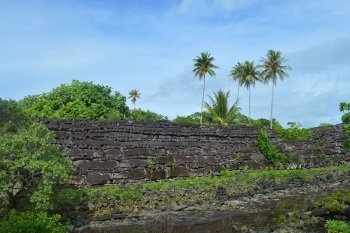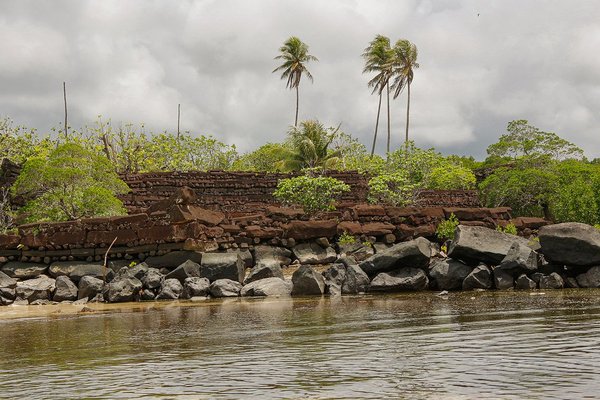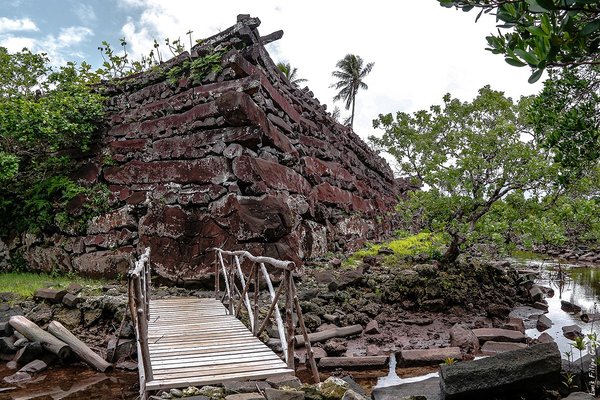Micronesia
Nan Madol
'Nan Madol: Ceremonial Center of Eastern Micronesia' covers megalithic monuments on nearly 100 artificial islets on a coral reef offshore of Pohnpei Island.
It was the ceremonial centre of the Saudeleur Dynasty (ca. 1200-1500 AD), who were the first to unify the people of Pohnpei and introduce a tribute system. The complex consisted of royal and commoners' residences, tombs and temples. Massive columnar basalt stones, transported from quarries elsewhere on the island, were used in its construction. The islands were linked by a network of canals. Nan Madol is still owned and managed by a traditional Pacific system of governance.
Community Perspective: a one-of-a-kind cultural masterpiece and the top attraction in the Pacific, perhaps even surpassing Easter Island. The site is easily accessed by boat or land tour (via the Pohnpei Surf Club) or by taxi from Kolonia. Be prepared that at the end of the trail, you have to wade to the ruins.
Site Info
Official Information
- Full Name
- Nan Madol: Ceremonial Center of the Eastern Micronesia (ID: 1503)
- Country
- Micronesia
- Status
-
Inscribed 2016
Site history
History of Nan Madol
- 2016: In Danger
- conservation project needed
- 2016: Revision
- On T List as "Ceremonial Centres of the Early Micronesian States: Nan Madol and Lelu" - Lelu was not proposed in 2016, but will be a future extension to the Nan Madol WHS
- 2016: Inscribed
- Inscribed
- In Danger
- conservation project needed Since 2016
- Type
- Cultural
- Criteria
- i
- iii
- iv
- vi
Links
- UNESCO
- whc.unesco.org
- Official
-
- nan-madol.com — Nan Madol Tourism
- Related
-
- smithsonianmag.com — Smithsonian Magazine: Nan Madol, the city built on coral reefs
All Links
UNESCO.org
- whc.unesco.org — whc.unesco.org/
Official Website
- nan-madol.com — Nan Madol Tourism
Related Resources
- smithsonianmag.com — Smithsonian Magazine: Nan Madol, the city built on coral reefs
Community Information
- Community Category
- Archaeological site: Pacific
Travel Information
Recent Connections
-
Austronesian cultures
Pohnpeian
-
Perfect Inscriptions
2016 -
Made out of basaltic material
"wall construction using massive column…
Connections of Nan Madol
- Individual People
-
-
Erich von Däniken
See Erich Von Daniken (1973), The Gold of the Gods, Chapter 4: "Temuen, The Island They Call Nan Madol"
-
- Geography
-
-
Situated in one of the SIDS
Federated States of Micronesia -
Located in a microstate
Federated States of Micronesia (702km2 / 106,104 inhabitants) -
Pacific Ocean
-
Micronesia
-
Atoll
Stone city on a coral atoll
-
- Trivia
-
-
Cultural sites closely connected to volcanoes
Carbon dating indicates that megalithic construction at Nan Madol began around 1180 AD when large basalt stones were taken from a volcanic plug on the opposite side of Pohnpei. (wiki) -
Dubbed as another WHS
It is often called the "Venice of the Pacific" (wiki) -
Built or owned by Americans
Nan Madol is a U.S.-designated National Historic Landmark. "As part of the Caroline Islands, Pohnpei was colonised by Spain in 1886; ceded to Germany after the Spanish American War; seized by Japan during World War I and after World War II became part of the Trust Territory of the Pacific Islands under United States administration in 1947. In 1979 the former Trust Territories became the Federated States of Micronesia and as an independent sovereign nation entered into a free association with the United States of America in 1986." - AB Evaluation -
Twin Towns
Nan Madol and Lelu (The similarity between the two sites is stressed in the Nom file as well as the future intention to extend the nomination to include Lelu.) -
Customary ownership
Nan Madol was granted to the government as public land following the development of the Trust Territory government in 1986 and also remains under the traditional customary ownership of the Nahnmwarki Madolenihmw (AB ev) -
Cultural sites taking up an entire island
on a series of 99 artificial islets (AB ev)
-
- History
-
-
Megalithism
outstanding monumental megalithic architecture (OUV)
-
- Ecology
-
-
Mangroves
-
Columnar Jointing
Nan Madol was built using columnar basalt quarried from various locations on the island of Pohnpei (wiki)
-
- Architecture
-
-
Made out of basaltic material
"wall construction using massive columnar basalt stones" (OUV)
-
- Damaged
- World Heritage Process
-
-
Directly in Danger
-
Perfect Inscriptions
2016 -
Slow Starters
2002 - 2016 -
First inscriptions
Federated States of Micronesia (2016) -
Only WHS in their country
Federated States of Micronesia -
Reduced from broader TWHS
Lelu was originally included
-
- Religion and Belief
-
-
Legends and Folk Myths
Nan Madol has been interpreted as the remains of one of the "lost continents" of Lemuria or Mu, although this is today considered falsified by plate tectonics (wiki) -
Living indigenous religions
it continues to retain religious and traditional significance (AB ev)
-
- Human Activity
-
-
Austronesian cultures
Pohnpeian
-
Aquaculture
"Other islets were used for functional activities including ............., clam aquaculture, ........, moray eel raising, food storage and preparation, sacrificial turtle husbandry" (AB ev) -
Artificial Islands
-
- Constructions
-
-
Necropolises
Madol Pah
-
- WHS on Other Lists
- Timeline
-
-
Built in the 13th century
Saudeleur Dynasty (ca. 1200-1600 AD)
-
- Science and Technology
News
No news.
Community Reviews
Show full reviews
My adventure began at Pohnpei Airport on a Saturday late afternoon, stepping off the famous United Island Hopper with my sights set on Nan Madol tomorrow. The plan was simple: rent a car, explore Pohnpei at my own pace, and lose myself in the shadows of one of the Pacific’s most enigmatic wonders on Sunday. Of course, travel rarely goes according to plan. The rental car mishap was my first hurdle! the local agency had completely forgotten my booking. Thankfully, the airport's free Wi-Fi saved the day, and an hour later, I was finally behind the wheel of a reliable 4WD to my hotel. However, I soon discovered that Micronesia isn’t part of my mobile roaming coverage. With the telecom office closed until Monday, I would have to navigate the island old-school with downloaded maps, instinct, and a dash of blind optimism.
Driving through Pohnpei is a dream in itself. The roads are narrow but scenic, winding through emerald jungles and sleepy coastal villages where locals wave as you pass. After about an hour of driving southeast from Kolonia, I turned off the main road and entered what could only be described as a slow-motion obstacle course. The final stretch leading to Nan Madol was an unpaved dirt road, riddled with potholes and in truly rough shape. Before entering this last section of local road, I paid a $25 entrance fee, and just before the walkway, an additional $3 for land access, as part of local arrangements with private …
Keep reading 0 comments
Mysterious ancient city built on coral rocks on the SE corner of Pohnpei. You can either get a boat there (nice approach from the sea) that can be arranged via Pohnpei Surf Club (google them) or drive about 1.5 hr to get there. I will talk about the second method since I did not take a boat. A taxi will cost you US$80 for one person and a bit more for the whole car if more than one person. I went with the taxi driver named Augustine (691)9264085 who is recommended by many on Facebook EPS. For US$80, he can drive you to multiple sites all over Pohnpei for a full day.I do not suggest you drive yourself due to the complexity of finding one’s way to the ruins from the car parking area. Your taxi driver can guide you to the ruins, especially on a foggy or rainy day when the very rough footpath (around 500m) becomes hazy and unclear. At the car parking area or shortly after, one will be approached by 2 separate locals asking for “entrance fees” of between US$1 and US$3. They are supposedly the local squatters and representatives of the traditional tribal ruler. The footpath is rocky (some parts of muddy) and slippery, and in my opinion, can potentially be dangerous for the elderly. At the end of the footpath is a narrow sea channel by the main ruins. Depending on the tide, the water can be between 20cm and 1 meter or more …
Keep reading 0 comments
Like others here, I arranged a trip with Pohnpei Surf Club for a vehicle from Kolonia to take us to Nan Madol. After getting near the site, we paid about 3 USD to the family who lives there, before walking about 15 minutes on a stone path (very slippery when it's pouring rain, like it was the day we went). As we get closer, huge walls made of columnar basalt seem to emerge out of the jungle. Finally, we approach the main islet - Nan Madol is made of several artificial islets criss-crossed by a series of canals, but most visitors only go to one islet, Nan Douwas - and what an islet it is! Enormous, imposing walls surround a central tomb, built for the first member of the dynasty that created Nan Madol, and a further set of outer walls as well, with remnants of structures in between the two walls. If this were in most other countries, it'd be a standout hit with tens or hundreds of thousands of visitors, but because Micronesia is so hard to get to, it gets very few - we were the only visitors we saw at the site that day. The temptation to make a comparison to Easter Island is obvious - while nothing on Pohnpei quite matches the artistry of the moai, no structure I saw on Easter Island matches the ones built at Nan Madol.
Keep reading 0 comments
Time of visit: August 2018
Duration of visit: 3 hours
Mode of transportation: within Pohnpei - a 1.5hr drive from Kolonia, followed by a channel crossing by foot; to Pohnpei, from San Francisco, then Honolulu, via the United Pacific Hopper flights through Majuro, Kwajalein, and Kosrae
Review and experience
The primary focus of my 2 days on Pohnpei was scuba diving - truly a diamond in the rough and underrated dive location. I was so close to choosing Chuuk over Pohnpei, as Chuuk had some impressive WWII dive sites and I could only select one stop-over along the United Pacific Hopper flights without extra costs, but Nan Madol ended up being the tie-break for selecting Pohnpei.
I'd like to think of Nan Madol as a sleeper hit WHS. Despite having taken a handful of archaeology courses in college, I hadn't heard of Nan Madol and the Micronesia dynasties! Perhaps I was asleep in class if one of my professors covered it for a brief few minutes, and if so, shame on me... While Nan Madol may not be as impressive as the likes of Machu Picchu, Chichen Itza, or the Great Pyramids, its truly lives up to its OUV in my perspective - a one of a kind cultural masterpiece. An added bonus to the experience was that I was the only visitor (aside from my guide/driver) to the site during my time there, so the experience was intimate and undisturbed by others. Venice of …
Keep reading 0 comments
Nan Madol, on the island of Pohnpei, came as a wonderful surprise to me as part of my trip flying on United's Island Hopper flight between Honolulu and Guam. It was a small city, constructed of stone on artificial islets along the coast of Pohnpei. Construction is dated to the late 1100s and it served as the capital of the Saudeleur Dynasty of the islands until 1628. The scale of it all is truly amazing. Great stone buildings separated by a series of ocean canals, protected by a large breakwater wall. The most impressive remnant is the tomb complex in the center, where the building's (palace's?) remaining walls are over 20 feet tall in spots. And what incredible walls these are! It is constructed of a mix of massive basalt boulders and huge hexagonal basalt crystals. You might be familiar with these hexagonal crystals from the Giant's Causeway in Northern Ireland. Here, long pieces of them are stacked to form walls, reminding me of a set of heavyweight Lincoln Logs, stacked in bunches to form these formidable walls. But the mystery of how this small island civilization constructed all this gets even better, because this type of basalt rock and crystal form is only found on the opposite side of the island! Some of these stones weigh many tons each. The local legends say that the stones were magically flown through the air from the other side of the island to build this city. However they managed to accomplish it, …
Keep reading 0 comments
I visited Nan Madol in 2007 and ever since I had thought it was not only worthy of world heritage status but probably the most deserving site I had been to which wasn't listed.
Getting to Micronesia isn't easy, and getting to Nan Madol takes a bit of effort once you are on Pohnpei, but it is well worth the effort. Expect to be alone when you visit or be among a very small number of tourists.
It has been called the "Venice of the Pacific" for good reason. The small islands and structures separated by canals evokes images of Venice.
I think that Nan Madol is the top attraction in the Pacific, perhaps even surpassing Easter Island.
Read more about Nan Madol: Ceremonial Centre of Eastern Micronesia on my website.
Keep reading 0 comments
In December 2015, I spent a couple of days in Pohnpei at the Mangrove Bay Hotel, a short walk from downtown Kolonia, the capital of Pohnpei. Kolonia is not a very interesting place, but I did manage to find a couple of historic sites like the Spanish wall, built in 1899 as a boundary for Fort Alphonso XII. The wall is one of the few remaining remnants of Spanish control and now serves as the outfield wall for the baseball field. I also wandered around and found the Catholic bell tower and adjoining masonry apse, all that remain of a church built in 1909 by German Capuchin missionaries, when Pohnpei and the other Caroline Islands were administered as part of German New Guinea.
I organized a trip to Nan Madol with Pohnpei Surf Club, which is located on the ground floor of the Mangrove Bay Hotel (www.pohnpeisurfclub.com). I paid US$125, which accounts for solo travel on Christmas (it should be less expensive with a group).
There is a tide chart stapled to the Pohnpei Surf Club's door, so you could time your visit to Nan Madol for low tide, as I did, when I was able to wade across the channel that separates the complex from the main island (at high tide, a visitor would need to swim or arrange for a kayak, which I heard is difficult to arrange).
From the Mangrove Bay Hotel, it was a 45-minute or so drive to the beginning of the footpath to Nan …
Keep reading 0 comments

